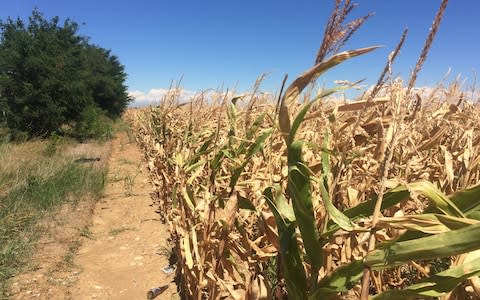Time to ditch the tractor? Why ploughing up the soil could be bad for farming

Farmers have been ploughing their fields and scattering seed for thousands of years, but now scientists have found that annually turning over the soil may not be the best way to grow crops.
Agricultural researchers have been concerned for some time that the world’s soils are running out of nutrients because of overuse, with some experts estimating there may be as few as 60 harvests remaining.
A 2015 report from the Food and Agriculture Organization (FAO)of the United Nations found that in the past 40 years the world has already lost a third of food-producing land due to diminished soil.
To find a solution, scientists at Stanford University looked back to see how farmers had coped during the 1930s Dust Bowl, when soils were severely degraded by over-planting and freak weather patterns.
They found that Midwest farms had reduced how much they tilled the soil, which increased corn and soybean yields while also allowing the land to recover, and lowering production costs.

The practice is still used on over 370 million acres today, mostly in South America, Oceania and North America, so Stanford teamed up with Nasa to use satellites to check if it was improving yields.
The researchers calculated corn yields improved an average of 3.3 percent and soybeans by 0.74 percent across fields managed with long-term conservation tillage practices in the nine states sampled. If it was reproduced globally it would bring and extra 11 million additional tons of corn and soy each year, matching the entire country output of South Africa, Indonesia, Russia or Nigeria.
“Reduced tillage is a win-win for agriculture,” said study lead author Dr Jillian Deines, of Stanford's Center on Food Security and the Environment
“Worries that it can hurt crop yields have prevented some farmers from switching practices, but we found it typically leads to increased yields.
"One of the big challenges in agriculture is achieving the best crop yields today without compromising future production and this research demonstrates that reduced tillage can be a solution for long-term crop productivity.”

Farmers generally plough up the soil prior to planting corn or soybeans - a practice known to control weeds, mix nutrients, break up compacted dirt and ultimately increase food production over the short term.
In contrast, conservation tillage involves leaving the previous year's crop residue, such as corn stalks, on the ground when planting the next crop, with little or no mechanical turning over of the ground.
It promotes healthier soil management, reduces erosion and runoff and improves water retention and drainage.
In the study, some areas experienced up to an 8.1 percent increase for corn and 5.8 percent for soybeans, however the team found that in water-logged soils, traditional turning of the soil was helpful for drying it out.
“Figuring out when and where reduced tillage works best could help maximize the benefits of the technology and guide farmers into the future,” added study senior author David Lobell, Professor of Earth systems science.
It will take time to see the results, with farmers unlikely to benefit for the first 11 years, the calculations showed. But it results in lower costs due to reduced need for labour, fuel and farming equipment while also sustaining fertile lands for continuous food production.
However the National Farmers Union (NFU) said moving the soil regularly could be beneficial, and that reduced tilling would not suit all crops or areas.
NFU environment policy adviser Philippa Arnold said: “Ploughing, where appropriate, does have multiple benefits and uses, such as weed control, establishing certain crops, for use in organic systems and it is the most effective way to invert all of the material when incorporating solid manure and solid digestate to bare land.
“With over 700 different soil types in the UK, there is no one size fits all approach where cultivation methods are concerned.
“An approach whereby the appropriate tillage is used for the farming system, and assessed on a field by field basis as part of good soil management would be a more pragmatic answer to soil improvement.”
The research was published in the journal Environmental Research Letters.

 Yahoo News
Yahoo News 
